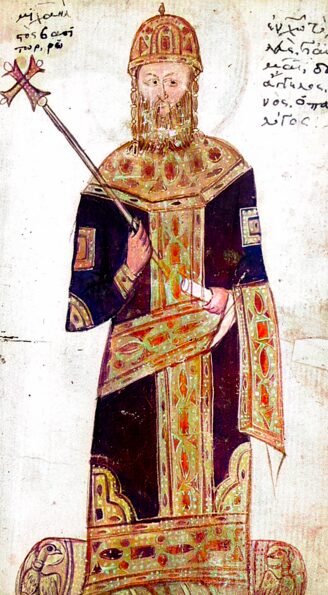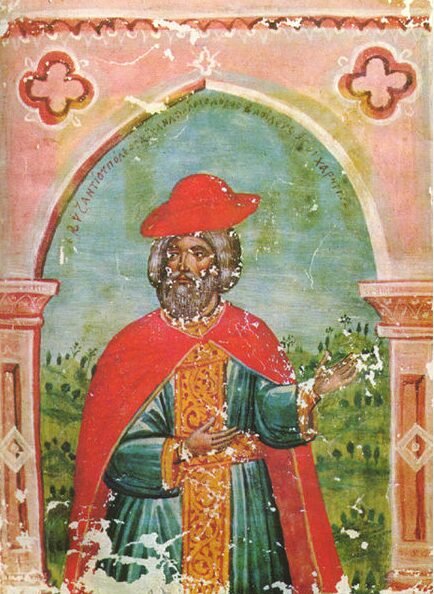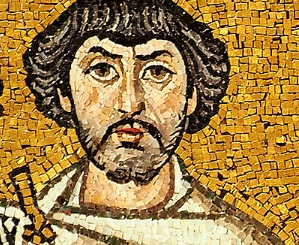Life and Major Accomplishments of Byzantine Emperor Michael VIII Palaiologos
Michael VIII Palaiologos was a pivotal figure in Byzantine history, playing a significant role in the final chapters of the Byzantine Empire. Born around 1223, Michael rose to power during a tumultuous period marked by the decline of Byzantine authority and the encroaching threat of the Latin Empire and other external forces.
His reign, which began in 1259 and lasted until his death in 1282, was characterized by both triumphs and challenges, ultimately culminating in the restoration of Constantinople to Byzantine control and the reestablishment of the Byzantine Empire as a major power in the region.

Michael VIII Palaiologos (1224-1282) ascended as Byzantine emperor in 1261, having been co-emperor of the Empire of Nicaea since 1259. He founded the Palaiologan dynasty, which lasted until the Fall of Constantinople in 1453. Image: Michael VIII Palaiologos’ portrait.
To understand Michael VIII Palaiologos and his significance, it’s essential to explore the context in which he lived and ruled. The Byzantine Empire, which had once been a vast and powerful state encompassing much of the eastern Mediterranean, had steadily declined over the centuries due to a combination of internal strife, external pressures, and territorial losses.
By the time Michael came to power, the empire was a shadow of its former self, reduced to a fraction of its former territory and struggling to maintain its independence against aggressive neighbors and rivals.
One of the most significant challenges facing the Byzantine Empire during Michael’s lifetime was the presence of the Latin Empire, which had been established in Constantinople following the Fourth Crusade in 1204.
The Latin Empire, ruled by a succession of Western European monarchs, posed a direct threat to Byzantine authority and sought to establish permanent control over the city of Constantinople and its surrounding territories. Michael VIII Palaiologos emerged as a key figure in the efforts to resist and eventually overthrow Latin rule in Constantinople.
Michael’s early years were marked by political intrigue and instability. He came from a noble Byzantine family with a long history of service to the empire, but his rise to power was anything but assured. After the death of Emperor John IV Laskaris in 1261, Michael seized the opportunity to assert his claim to the throne, leading a successful coup against the ruling regent and assuming the title of emperor. His accession to power marked the beginning of a new era for the Byzantine Empire, as Michael set about consolidating his authority and pursuing his vision of restoring Byzantine control over Constantinople and its territories.

John IV Doukas Laskaris was born on December 25, 1250, and became the Emperor of Nicaea on August 16, 1258. His reign lasted until December 25, 1261. Image: John IV Doukas Laskaris, empeor of Nicaea from 1258 to 1261.
One of Michael’s most significant achievements was the recapture of Constantinople from the Latin Empire in 1261. Taking advantage of internal divisions within the Latin Empire and with the support of powerful allies, including the Republic of Genoa, Michael launched a bold military campaign to reclaim the city that had served as the capital of the Byzantine Empire for centuries.
In a dramatic turn of events, Byzantine forces under Michael’s command successfully breached the walls of Constantinople and drove out the Latin occupiers, restoring the city to Byzantine control after nearly sixty years of foreign rule.
The reconquest of Constantinople was a major turning point in Michael’s reign and in Byzantine history as a whole. With the restoration of the city to Byzantine control, Michael was able to reestablish Constantinople as the capital of the Byzantine Empire and restore the prestige and authority of the imperial throne. The recapture of Constantinople also served to reassert Byzantine influence in the eastern Mediterranean and to check the expansion of rival powers in the region.
However, Michael’s reign was not without its challenges and controversies. His efforts to consolidate power and strengthen the Byzantine state often brought him into conflict with powerful internal and external adversaries, including rival claimants to the throne, ambitious nobles, and foreign powers seeking to exploit Byzantine weaknesses for their own gain.

Michael’s policy of centralization and his use of ruthless tactics to suppress dissent and maintain control earned him both admirers and critics, and his reign was marked by frequent rebellions and uprisings against his rule.
In addition to his military and political accomplishments, Michael VIII Palaiologos was also a patron of the arts and culture, and his reign saw a revival of Byzantine art, literature, and scholarship.
He commissioned numerous works of art and architecture, including churches, palaces, and monuments, and he supported the work of scholars and intellectuals who sought to preserve and promote Byzantine culture in the face of external threats and internal upheaval. Michael’s patronage helped to foster a renewed sense of Byzantine identity and pride, even as the empire continued to face challenges to its survival.

Michael VIII Palaiologos died in 1282, leaving behind a mixed legacy as one of the last great emperors of Byzantium. His reign marked a brief period of resurgence and revival for the Byzantine Empire, but it was ultimately unable to reverse the long-term decline that had plagued the empire for centuries.
Nevertheless, Michael’s efforts to restore Byzantine control over Constantinople and his contributions to the cultural and intellectual life of the empire ensured that his name would be remembered as a significant figure in Byzantine history.
He was succeeded by his oldest son, Andronikos II Palaiologos, whose reign saw the onset of the Byzantine Empire’s final decline, characterized by the loss of Anatolian territories to the Turks and significant internal strife.
Did you know…?
Internal opposition, led by figures like the deposed Patriarch Arsenios and his followers (the Arsenites), significantly disrupted Michael’s reign, leading to widespread discontent and frequent punitive actions against dissenters.
Michael’s reign saw the revival of Byzantine naval power with 80 ships and the restoration of traditional administrative structures. However, his focus on Europe weakened Anatolian defenses, hastening frontier collapse under Turkish pressure. His dynasty lasted nearly two centuries, the longest in Roman history.
Michael VIII Palaiologos had two illegitimate daughters with a mistress, a Diplovatatzina. His daughter Euphrosyne Palaiologina married Nogai Khan of the Golden Horde, an influential Mongol leader. His other daughter, Maria Palaiologina, married Abaqa Khan, who was the ruler of Ilkhanid Persia. These marriages strategically linked the Byzantine Empire with powerful Mongol states, reflecting Michael’s diplomatic efforts to secure alliances across the region, bolstering Byzantine influence and security through marital ties with significant Eurasian rulers.
FAQs
Here are some questions and answers based on the extensive historical period of Michael VIII Palaiologos’s reign and the numerous political and military challenges he faced:
Who were the parents of Michael VIII Palaiologos?
Michael VIII Palaiologos was the son of Andronikos Palaiologos, who held the position of megas domestikos (great domestic or commander-in-chief) of the Empire of Nicaea, and Theodora Angelina Palaiologina, who was the granddaughter of Emperor Alexios III Angelos (reign: 1195 – 1203).
What is notable about Michael VIII’s ancestry?
Michael VIII’s ancestry is notable for its connections to three imperial houses that ruled the Byzantine Empire before the Sack of Constantinople in 1204. His lineage included ties to the Angelos, Doukas, and Komnenos families, all prominent dynasties in Byzantine history.
Who raised Michael VIII during his early years?
According to some historians, Michael VIII’s mother, Theodora Angelina Palaiologina, did not play a significant role in his early life.
For a period during his early years, Michael VIII was raised by his elder sister, Martha. Martha was married to Nikephoros Tarchaneiotes, who also held the title of megas domestikos.

Michael VIII rose to distinction serving as the governor of the Thracian towns of Melnik and Serres under his father, Andronikos Palaiologos.
What accusation did Michael VIII face under Emperor John III Vatatzes?
In the autumn of 1253, Michael VIII was accused of plotting against the throne of Emperor John III Vatatzes.
Michael VIII showcased his future political astuteness by proposing that Metropolitan Phokas of Philadelphia, who supported the trial by ordeal, should first take the red-hot iron from the altar and place it in Michael’s hands, asserting he would accept it to reveal the truth. Michael avoided punishment following the trial by ordeal.
He was also appointed as megas konostaulos of the Latin mercenaries in the service of the Empire of Nicaea, although he remained under suspicion.
Who was his spouse?
After his trial by ordeal, he was married to Theodora Palaiologina (c. 1240 – 1303), the Emperor’s grandniece.
Theodora and Michael VIII Palaiologos had seven children, including Andronikos II, who succeeded as emperor, and several daughters who married into other royal families, strengthening Byzantine alliances across the region. Their progeny played significant roles in European politics through these strategic marital ties.
What significant action did Michael take after the death of John Vatatzes?
After the death of John Vatatzes, Michael crossed the Sangarios River and briefly took service with the Seljuk Sultanate of Rum. He served as a commander of Christian mercenaries until 1258, when he was recalled by Emperor Theodore II Doukas Laskaris (reign: 1254- 1258).
Shortly after Theodore Laskaris’s death in 1258, Michael instigated a coup against the influential bureaucrat George Mouzalon, taking over the guardianship of the young Emperor John IV Doukas Laskaris.
Michael was invested with the titles of megas doux and despotes, and on January 1, 1259, he was formally proclaimed emperor, most likely without John IV’s presence, in Nymphaion.
How did Michael VIII Palaiologos reconquer Constantinople?
In 1259, Michael VIII Palaiologos decisively defeated the alliance of William of Villehardouin and Michael II Komnenos Doukas at the Battle of Pelagonia, an event crucial to his aspirations. This victory, by averting immediate threats from the west, bolstered his reputation as a capable leader.
Despite his success, Michael was still seen as a usurper until he recaptured Constantinople in 1261. His first attempt in 1260 failed, leading to a temporary truce with the Latin Emperor Baldwin II. A strategic alliance with Genoa in 1261, aimed to secure naval support, turned out to be unnecessary when his general, Alexios Strategopoulos, captured the city through subterfuge.
Upon regaining Constantinople, Michael restored Byzantine traditions and significantly increased the city’s population. He also took harsh measures to secure his rule, including blinding the young co-emperor John IV Laskaris and marrying off potential rivals, ensuring his family’s dominance and eliminating threats to his legitimacy.

John IV Laskaris’s tenure ended when Michael VIII Palaiologos, who restored the Byzantine Empire by recapturing Constantinople, usurped his throne and later blinded him, making him ineligible to rule. John IV died around 1305. Image: Michael VIII.
What was Michael VIII Palaiologos’s early reign like?
The fall of Constantinople to Michael VIII not only diminished the papacy’s political prestige but also severely damaged its spiritual authority, as it allowed the Greeks to reassert their independence from the Roman Church, intensifying the schism.
Michael VIII sent two envoys to Pope Urban IV, but upon reaching Italy, one envoy was seized and flayed alive, while the other managed to escape and return to Byzantine territories.
In the mid-1260s, Michael VIII faced several military defeats during this period: a failed expedition to conquer the Principality of Achaea in 1263, a naval defeat at the Battle of Settepozzi by Venetian forces, and a defeat at Makryplagi where Seljuk mercenaries switched sides due to unpaid wages. In 1265, Michael narrowly escaped an ambush by Tatars and Bulgars in Thrace.
After his military setbacks, Michael VIII dismissed the 60 Genoese galleys he had hired and began to mend relations with Venice. He secretly negotiated a treaty offering terms similar to the Treaty of Nymphaeum, although it was not ratified by the Doge Raniero Zeno.
What was the outcome of Michael VIII’s attempt to help the deposed Sultan ʿIzz ad-Dīn Kaykāwūs?
Michael VIII was unable to assist ʿIzz ad-Dīn Kaykāwūs significantly, as aligning with him risked conflict with the Mongols who supported Kaykāwūs’s enemies. Ultimately, ʿIzz ad-Dīn was imprisoned, and later freed by Mongol troops from Russia, who took him to Crimea where he spent the rest of his life.
How did Michael VIII’s marriage proposal to Anna of Sicily turn out?
Michael VIII’s proposal to divorce his wife Theodora and marry Anna of Sicily was rejected by Anna. His wife, Theodora, upset by the proposal, sought help from Patriarch Arsenios, who pressured Michael to abandon his plans. Michael complied, sending Anna back to Sicily with gifts.
What was the significance of the Battle of Benevento in 1266 for Michael VIII?
The Battle of Benevento in 1266 marked the rise of Charles of Anjou as a significant adversary to Michael VIII. Charles’s victory there cemented his control over Sicily and positioned him as a major contender against the Byzantine Empire, threatening to re-impose Latin rule over Constantinople.
In May 1267, Charles of Anjou solidified his position by signing the Treaty of Viterbo with Baldwin II and William II Villehardouin, under Pope Clement IV’s guidance, which aimed at restoring the Latin Empire and countering Byzantine influence.
What challenges did Michael VIII face on his Asian frontier?
Michael VIII faced challenges from Turkmen infiltrating Byzantine territories in Asia, exacerbated by his preoccupation with threats from the West. This lack of organized response led to the loss of key cities and regions to these nomadic groups.
How did Michael VIII respond to the Treaty of Viterbo?
Michael VIII sought to undermine the Treaty of Viterbo by negotiating church union with Pope Clement IV, attempting to weaken papal support for Charles of Anjou’s campaigns against Byzantium.
What strategic diplomatic move did Michael VIII make involving King Louis IX of France?
Michael appealed to King Louis IX, Charles of Anjou’s elder brother, highlighting the need for a crusade against Muslims rather than a campaign against a Christian state like Byzantium, which helped delay Charles’s plans against Constantinople.
What was the outcome of the Second Council of Lyon in 1274 for Michael VIII?
At the Second Council of Lyon in 1274, Michael VIII achieved a temporary ecclesiastical union between the Eastern and Western Churches, which bolstered his legitimacy and temporarily deterred papal support for crusades against Byzantium.
What military challenges did Michael VIII face in his later years?
Michael VIII faced several military setbacks including defeats in Bulgaria and Thessaly, and while he had some naval successes, these were overshadowed by losses and ongoing conflicts that drained resources.
Also, the Sicilian Vespers, a rebellion against Charles of Anjou, drastically shifted the power dynamics in the Mediterranean, relieving Byzantine pressures as Charles’s attention turned towards retaining control of Sicily.
Michael VIII was instrumental in instigating and supporting revolts in Crete against Venetian rule as part of his broader strategy to weaken Venetian economic and military power in the region.

How did Michael VIII Palaiologos die?
Michael VIII Palaiologos died on 11 December 1282 in Pachomios, Thrace. Due to his controversial religious policies, he was initially denied burial in Constantinople and was interred at Nea Mone Monastery in Rhaidestos (modern Tekirdağ, Turkiye). In 1285, his remains were moved to the Monastery of Christ in Selymbria.
Who succeeded Michael VIII Palaiologos?
Michael VIII Palaiologos was succeeded by his son, Andronikos II Palaiologos, who became emperor of the Byzantine Empire in 1282 after his father’s death. Andronikos II’s reign lasted until 1328, marked by a significant decline in the empire’s fortunes due to economic difficulties, military setbacks, and internal conflicts.

Andronikos II Palaiologos, born on March 25, 1259, reigned as Byzantine Emperor from 1282 until his forced abdication in 1328. His reign ended with the First Palaiologan Civil War against his own grandson, leading to his abdication. Andronikos then retired to a monastery, where he lived until his death on February 13, 1332. Image: Andronikos II Palaiologos.



























